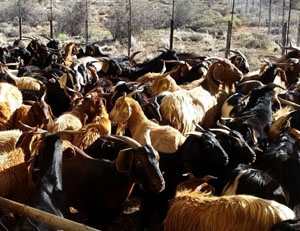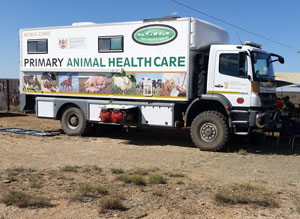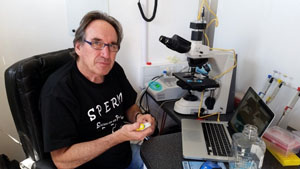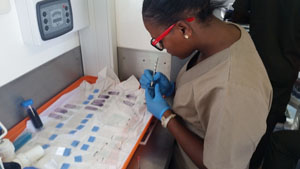A unique indigenous breed of South African goat: Semen and sperm analyses of Tankwa goats using SCA 6.2

Tankwa goats in Carnarvon, Northern Cape, South Africa.
Tankwa goats are indigenous to South Africa. A genetic study indicated that these goats are a unique breed and accordingly different from the Boer and Angora breeds. It appears that Tankwa goat origin dates back 50 years from an isolated population of feral goats found in the very dry Karoo area, mainly the Tankwa Karoo National Park, in South Africa. More than 250 of these goats were moved from the park to the Carnarvon Research Station (Department of Agriculture, Land Reform and Rural Development), Northern Cape, South Africa. This translocation was done in an effort to prevent that they become extinct but also because they have become a threat consuming scarce indigenous plants found in the park.
Tankwa goats have a remarkable ability to survive in the harsh environment of the Karoo (minus zero and plus 40oC temperatures; little water and food). They have greater resistance to diseases than any other goat populations in South Africa including exotic breeds and they are also very resilient to parasites. Furthermore, the breed is highly adapted to living without human intervention and their gene pool may harbor genetic characteristics that could be of value to commercial goat production.
It is accordingly not surprising that The National Zoological Gardens in Pretoria launched a research programme to study these goats in more detail including their reproduction. The comparative sperm group at the University of the Western Cape assisted with semen/sperm analysis during the past three years. In this blog I will focus on the studies performed on the spermatology of this breed.

Top class research vehicle.
In order to perform sperm/semen analysis, it was critical to have good facilities. The Department of Agriculture designed a “space age” research vehicle to be used under any field conditions. There are three labs inside with air conditioning, electricity, water, etc. as if it was a lab in a modern Science building. In this vehicle we operated two SCA 6.2 systems to study basic sperm parameters and sperm functionality. Apart from obtaining the basic sperm parameters such as sperm concentration and motility characteristics we studied sperm hyperactivation in great detail. Hyperactivation is indicative of fertilization outcome and live birth outcome. In most goats the percentage sperm motility was >89% and the percentage hyperactivation were considerably higher than the 20% cut-off point. A high percentage of intact acrosomes were also evident using the SCA FluAcro procedure. Furthermore, SCA sperm morphology assessment showed that most goats had a high percentage of normal sperm and furthermore that seasonal differences in sperm quality could be detected.
In conclusion it appeared that the sperm sampled from these goats were of a very high quality and explained the high level of fertility in in vivo conditions. Darwinian Natural selection!!!?
Gerhard van der Horst (PhD, PhD)
Senior Consultant
MICROPTIC S.L.





Leave A Comment